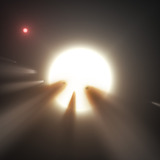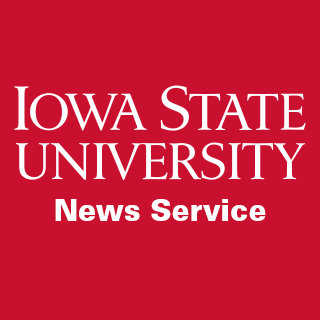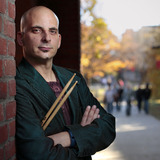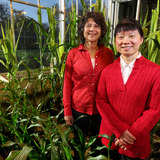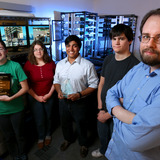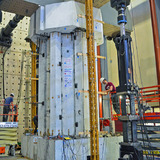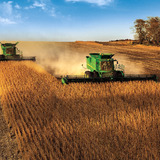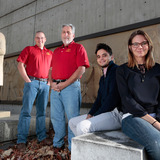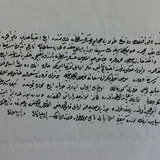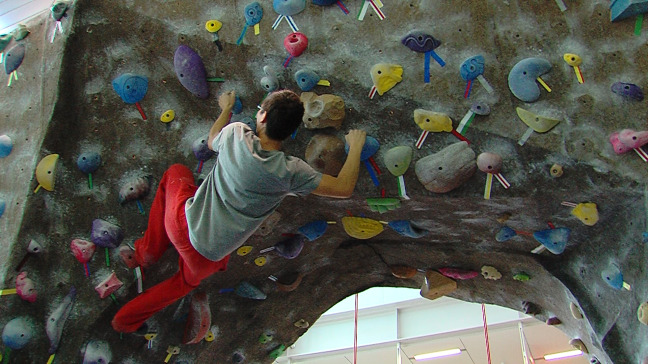News Archive
Tuesday, November 24 2015
-
Iowa State astronomers say comet fragments best explanation of mysterious dimming star
A team of astronomers led by Iowa State's Massimo Marengo responded to the buzz about a mysterious dimming star by studying data from NASA's Spitzer Space Telescope. Were there natural explanations for the dimming? Or were alien megastructures blocking the star's light? In a paper recently published online, Marengo and his colleagues conclude the dimming was probably caused by a family of comets breaking apart in front of the star.
-
AAAS recognizes six Iowa State researchers for their distinguished science
The American Association for the Advancement of Science is recognizing six Iowa Staters for their distinguished work in neuroscience, math, biochemistry, livestock genomics, physics and crop genomics. The six are part of the association's new class of fellows.
-
President's letter to the university community
Iowa State University President Steven Leath outlines a number of steps taken toward greater inclusion and diversity on campus.
-
Distinguished ecologist will talk about Southeast Asian biodiversity Dec. 3 at ISU
Renowned conservation biologist David Wilcove will present the Paul L. Errington Memorial Lecture at Iowa State University on Thursday, Dec. 3. "Saving Biodiversity in Southeast Asia" will be at 8 p.m. in the Memorial Union Great Hall. A professor at Princeton University, Wilcove has worked as an ecologist for the Environmental Defense Fund, The Wilderness Society and The Nature Conservancy. His talk is free and open to the public.
-
Change Agent: Zlatan Križan
Iowa State's Zlatan Krizan is working to understand how poor sleep affects our emotions, motivations and interactions with other people. The research is a natural extension of his work as director of the Sleep, Self, and Personality Laboratory.
-
‘Orphan gene’ may have potential to boost protein value of crops, according to Iowa State University research
A recently published study from two Iowa State University scientists shows that a gene found only in a single plant species can increase protein content when introduced into staple crops.
-
ISU’s landscape architecture and architecture programs rank in top 20 nationally
Iowa State University’s undergraduate programs in landscape architecture and architecture are ranked in the top 20 in the nation, according to a new survey of practitioners by DesignIntelligence. The survey placed Iowa State’s undergraduate landscape architecture program eighth and architecture program 20th in the United States for 2016. DesignIntelligence is a bimonthly publication for leaders in design professions. The magazine’s annual report, “America’s Best Architecture and Design Schools,” is the only national college ranking survey that focuses exclusively on design.
-
Iowa State student cyber analysts win national competition
A team of Iowa State University students won the National Cyber Analyst Challenge in Washington, D.C. To bring home the $25,000 prize, students had just five hours to comb through massive data files to determine the source and extent of a cyber attack.
-
Iowa State engineers test taller wind turbine towers made from precast concrete
Iowa State University engineers are testing new concrete technology for taller wind turbine towers. The idea is to find a way to build taller towers that can be easily transported and assembled on site. The towers could reach much higher than today's 80-meter steel towers, providing energy companies access to the faster and steadier winds above 100 meters.
-
Iowa State Stand-Up Comedy Club builds confidence through laughter
The Iowa State Stand-Up Comedy Club is about more than telling jokes and making people laugh. Students say performing on stage builds self-confidence and skills they'll use in their future careers.
-
ISU-licensed tech wins big at international ag expo
Technology related to harvesting equipment developed at Iowa State and licensed to John Deere will receive a trio of innovation awards at an international ag expo next week.
-
Industrial design students are players in bringing new sports products to market
An evolving partnership between the ISU Department of Industrial Design and Shock Doctor, a leading manufacturer of protective and performance sports equipment, has resulted in internships, sponsored studios, student projects and products that will be launched in 2016.
-
Strong marketing department drives firm performance, Iowa State researcher finds
New research from Iowa State University's College of Business underscores the importance of a strong marketing department. Not only does marketing create value for a firm's short-term profitability, but it also has a positive effect on long-term shareholder value. The study, published in the Journal of Marketing, includes data for more than 600 U.S. firms over a 16-year period.
-
ISU veterinary researchers discover mystery virus that causes tremors in piglets
ISU veterinary researchers have identified a pestivirus that has caused congenital tremors in piglets for decades. The research may pave the way toward a vaccine to combat the virus.
-
Iowa State helps launch SEEDCorn, a Midwest Big Data Hub supported by the NSF
The National Science Foundation announced today it has launched four regional big data hubs, including a Midwest hub that includes Iowa State University. The Midwest hub will have research themes closely related to Iowa's economy and Iowa State's strengths, including digital agriculture, advanced manufacturing, smart cities, transportation and a theme related to water, food and energy.
-
ISU history professor examines environmental cost of tapping alternate sources for water, oil
Saudi Arabia is known as one of the top oil producing countries in the world. However, an Iowa State University professor of history says it may have never earned that reputation if not for a quest to find fresh drinking water in the late 19th century, because of drought and repeated cholera outbreaks.
